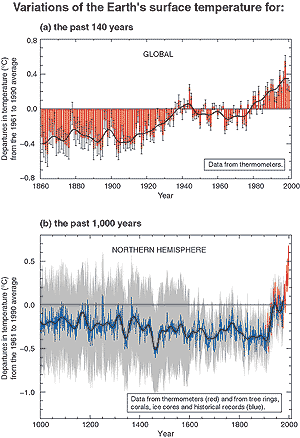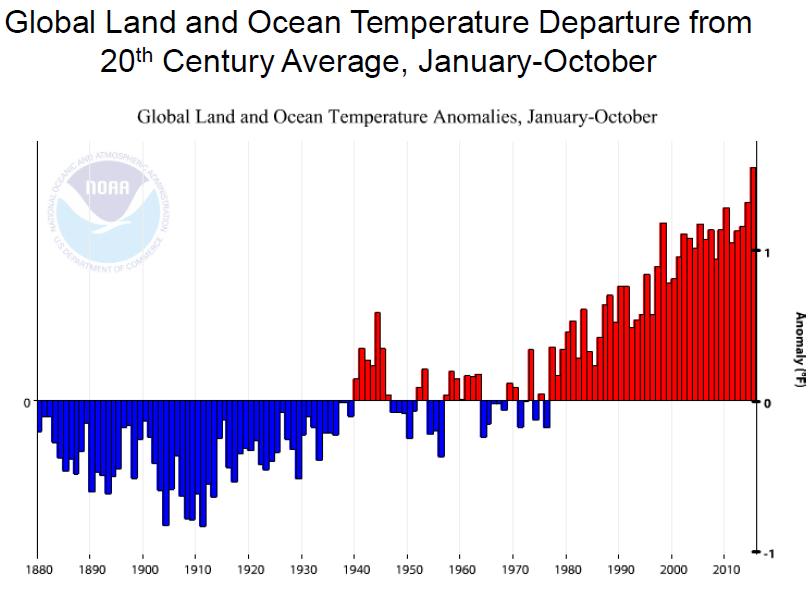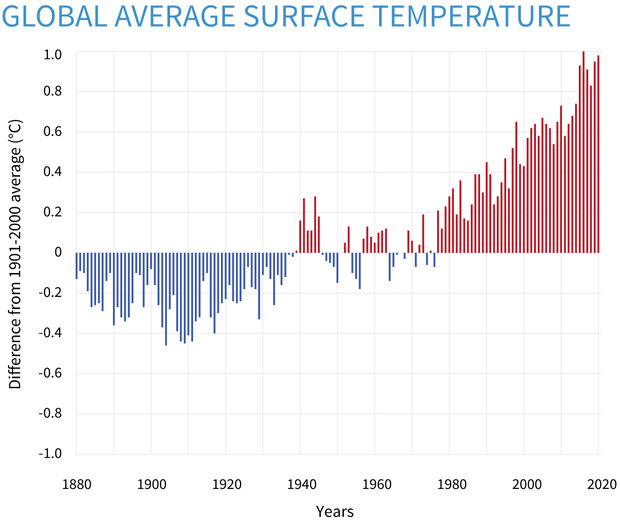During the Twentieth Century Earth's Average Surface Temperature
During the 20th century the sea surface temperature increased for a century and continued to rise. January 2021 also marked the 45th consecutive January and the 433rd consecutive month with temperatures at least nominally above the 20th-century average.

Ipcc Intergovernmental Panel On Climate Change
Too many plants on the surface of the Earth which prevent cooling of the surface 18.

. The pause in global warming observed since 2000 followed a period of rapid acceleration in the late 20th century. Human influence on climate has been the dominant cause of observed warming since the mid-20th century while global average surface temperature warmed by 085C between 1880 and 2012 as reported in the IPCC Fifth Assessment Report or AR5 IPCC 2013b 1. The global surface temperature for January 2022 was 089C 160F above the 20th century average and the sixth highest for January since global records began in 1880.
1 occurring from 1910 to 1940 and from 1970 to the present. According to data collected by Bloomberg from the NOAA the global temperature average has increased by 082 degrees Celsius when compared to the 20 th century average. Despite ups and downs from year to year global average surface temperature is rising.
Mid-20th Century Cooling. See all climate myths in our special feature. This was the fourth-warmest November on.
The last eight Januarys 20152022 rank among the 10 warmest Januarys on record. History of Earths surface temperature 1880-2016. The January global land and ocean surface temperature was 160 degrees F 089 of a degree C above the 20th-century average making it the sixth-warmest January in the 143-year climate record.
The global average surface temperature rose 06 to 09 degrees Celsius 11 to 16 F between 1906 and 2005 and the rate of temperature increase has nearly doubled in the last 50 years. There was a very slight cooling in the average global surface temperature from about 1940 to 1975. How much did the average surface temperature increase during the twentieth century.
Scientists have been building estimates of Earths average global temperature for more than a century using temperature records from weather stations. This animation shows annual temperatures each year since 1880 compared to the twentieth-century average ending with record-warm 2016. Last month was also the 46th consecutive January and the 445th consecutive month with temperatures above the 20th-century average.
The average global land and ocean surface temperature for November 2021 was 164 degrees F 091 of a degree C above the 20th-century average of 552 degrees F 129 degrees C. According to an ongoing temperature analysis led by scientists at NASAs Goddard Institute for Space Studies GISS the average global temperature on Earth has increased by at least 11 Celsius 19 Fahrenheit since 1880. After rising rapidly during the first part of the 20 th century global average temperatures.
There were of course natural influences on world climate during this time. To find out more about how the Earth is warmed and the greenhouse gases that are responsible see How Atmospheric Warming Works and. From 1901 to 2015 the temperature increased by an average of 013F per decade.
This value is about 015C larger than that estimated by the SAR 4 for the period up to 1994 owing to the relatively high temperatures. The majority of the warming has occurred since 1975 at a rate of roughly 015 to 020C per decade. The 2011 NOAA surface temperature anomaly of 051 C gives an average Earth temperature of 144 C for 2011.
Because of global warming due to increasing greenhouse gases the maps from the early years in the animation are dominated by shades of blue indicating. Over the 20th century the increase has been 06 02C 5 6 Figure 1a. During the twentieth century world average surface temperature increased by approximately 06C Figure 11.
The time series of globally averaged temperature at the Earths surface over the past 150 years prominently used in the assessment reports of the. Many regions of the world have already greater regional-scale warming with 2040 of the global population. Starting in the mid-1970s global temperatures rose 05 C over a period of 25 years.
Although the global temperature only decreased by approximately 01C this period represents a divergence from the warming periods of 1915 to 1940 and 1975 to Present. Temperatures are certain to go up further. Nine of the 10 warmest years since 1880 have occurred since the year 2000 as the Earth has experienced sustained higher temperatures than in any decade during the 20th century.
The rate of increase however increased to roughly 018 degrees Celsius each decade since 1981 signaling a quickening of both warming surface and ocean temperatures across the globe. The average surface temperature on Earth is approximately 72C though as already noted this varies. Since the turn of the century however the change in Earths global mean surface temperature has been close to zero.
While average global temperature will still fluctuate from year to year scientists focus on the decadal trend. This graph illustrates the change in global surface temperature relative to 1951-1980 average temperatures. But before 1880 there just wasnt enough data to make accurate calculations resulting in uncertainties in.
The global average surface temperature the average of near surface air temperature over land and sea surface temperature has increased since 1861. NOAAs result for the 20th century average land-ocean Earth surface temperature is 139 C. Since reliable observations began in 1880 the sea surface temperature has been higher than at any other time in the past three decades.
The January 2021 global land and ocean surface temperature was 080C 144F above the 20th century average and ranked as the seventh warmest January in the 142-year global records. In this case 1976 emerges as the last year in which the global-average temperature was below the 20th century average of 570F 139C thats 38 years ago the year that Nadia Comaneci scored. The National Oceanic and Atmospheric Administration NOAA reported average surface temperatures on Earth rose on average 171 degrees Fahrenheit 095 degrees Celsius between 1880 and 2016.
These include an increase in volcanic activity between 1960 and 1991 when Mount Pinatubo erupted which induced a net. Observations of the Earths near-surface temperature show a global-mean temperature increase of approximately 06 K since 1900 ref. Earths surface continues to significantly warm with recent global temperatures being the hottest in the past 2000-plus years.

What Was The 20th Century Global Temperature Average Quora

How Many Degrees C The Will Increase The Average Temperature On The Earth By The End Of The 21st Century

The Planet S Temperature Is Rising Union Of Concerned Scientists
No comments for "During the Twentieth Century Earth's Average Surface Temperature"
Post a Comment